Sometimes, we treat problem-solving like a solo mission. Think about those moments you pretend to be engrossed in work while actually playing solitaire on the office computer. But let's be honest, how many times has a stubborn problem left you stumped? More often than not, the magic ingredient to overcoming these challenges is collaboration. Working in isolation might feel productive, but it rarely leads to groundbreaking solutions. Instead, inviting diverse perspectives into the mix can elevate your problem-solving skills to, well, superhero levels.

Successful teamwork is not a new concept. It's the secret sauce behind our favorite sports teams, bands, and even iconic TV shows like Scooby-Doo. Yes, you heard right. The gang from Scooby-Doo might just be the epitome of collaborative problem-solving. Imagine the Mystery Machine breaks down. Each member of the gang brings a unique skill to the table. Velma dives into the problem with logic, Daphne injects creativity, Fred leverages his strength, and Shaggy keeps the peace - all while Scooby... well, Scooby does his best. The point? Their diverse abilities, when combined, form an unstoppable problem-solving force.
Now, applying Scooby-Doo’s tactics to the workplace might sound far-fetched, but the principle remains solid. Diversity of thought and skill in a team can turn any challenge into a solvable puzzle. Here’s how:
1. Embrace different perspectives: Welcome ideas and solutions from all team members, regardless of their role or seniority, which fosters creativity and innovation by drawing from a wide pool of experiences and viewpoints for the working environment.
2. Play to each other's strengths: Identify and utilize the unique skills and talents each team member brings. Leveraging individual strengths maximizes productivity and ensures tasks are completed efficiently.
3. Keep communication open: Ensure every voice is heard, and every suggestion is considered. Effective communication promotes collaboration, prevents misunderstandings, and strengthens team cohesion.
By following these simple strategies, you're not just solving problems more efficiently; you're fostering an inclusive and dynamic working environment that values diversity, optimizes teamwork, and cultivates a culture of mutual respect and understanding.
Here are some tools that assist in workplace collaboration, including both hardware and software:
1. IQShare WP45 Wireless Presentation System: This innovative system simplifies content sharing between students and teachers, enriching classroom collaboration and interaction. Its wireless functionality enhances flexibility, allowing seamless screen sharing among users for effortless communication.
2. Q-NEX Networked Media Processor (NMP): Serving as the central control hub for classroom AV devices, the Q-NEX NMP optimizes multimedia management and control. Educators benefit from its intuitive interface, streamlining the orchestration of interactive displays, projectors, and audio systems for engaging learning experiences.
3. IQTouch Interactive Flat Panel (IFP): Designed to create dynamic learning environments, the IQTouch IFP fosters interactive teaching experiences. Its touch-screen interface and collaborative features empower educators to deliver engaging lessons, encourage hands-on activities, and boost student participation in the classroom.
4. IQVideo Lecture Capture System LCS710: This system simplifies lecture recording with its user-friendly touch panel, enabling automatic recording or live streaming of courses. Teachers enjoy a seamless teaching experience while having recorded files available for review and evaluation.

1. Microsoft Teams: This unified communication and collaboration platform offers chat, video conferencing, file sharing, and integration with other Microsoft 365 apps, facilitating seamless teamwork and communication.
2. Slack: A messaging platform that enables real-time communication through channels, direct messages, and integrations with other tools. Slack enhances collaboration by organizing conversations, sharing files, and integrating with various third-party apps.
3. Zoom: A popular video conferencing software that allows teams to hold virtual meetings, webinars, and remote presentations. Zoom features HD video and audio, screen sharing, and interactive collaboration tools like whiteboarding and annotations.
4. Google Workspace (formerly G Suite): Google's suite of productivity tools includes Gmail, Google Drive, Google Docs, Sheets, Slides, and more. These cloud-based applications enable real-time collaboration on documents, spreadsheets, and presentations, fostering teamwork and productivity.
5. WebEx: A video conferencing and collaboration tool that offers virtual meetings, webinars, training sessions, and online events. WebEx provides HD video and audio, screen sharing, recording, and interactive features for effective communication and collaboration.
Below demonstrates the trends underscore the evolving nature of collaboration in the workplace and the importance of adapting to new challenges and opportunities to foster a culture of collaboration and innovation.
1. Emphasis on Remote Collaboration: With the rise of remote work, organizations are investing in tools and technologies that facilitate seamless virtual collaboration. Research suggests that effective remote collaboration requires clear communication channels, accessible collaboration platforms, and strong team dynamics despite physical distance.
2. Cross-Functional Collaboration: Organizations are increasingly recognizing the value of cross-functional collaboration, where teams from different departments work together to achieve common goals. Research indicates that cross-functional collaboration fosters innovation, breaks down silos, and improves decision-making processes.
3. Focus on Diversity and Inclusion: Research shows that diverse teams are more innovative and perform better. Thus, there's a growing emphasis on fostering diversity and inclusion in the workplace to enhance collaboration. Organizations are implementing strategies to create inclusive environments where all voices are heard and valued, leading to more effective collaboration.

4. Adoption of Agile Practices: Agile methodologies, originally developed for software development, are increasingly being applied to other areas of business, promoting collaboration, adaptability, and iterative problem-solving. Research suggests that agile practices, such as Scrum and Kanban, enable teams to respond quickly to changing circumstances and deliver value more efficiently.
5. Utilization of Collaboration Tools: The proliferation of collaboration tools such as Slack, Microsoft Teams, and Zoom has transformed the way teams work together. Research indicates that these tools improve communication, streamline workflows, and enhance team collaboration, especially in remote or hybrid work environments.
The truth is, in problem-solving, just like in life, collaboration trumps going it alone. Teams that can harness the power of their collective skills and perspectives don’t just solve problems; they innovate and blaze trails. Remember, while there might be no "I" in "team," there's definitely a "we" in "win."
So next time you're faced with a head-scratcher, take a leaf out of Scooby-Doo’s book. Rally your team, mix up your skills, and dive into the challenge together.
Here are some other articles that we think might interest you:
How to optimize your conference room? A Guide for Enhanced Collaboration
Transformative Collaborative Learning: Navigating Online Platforms
Tools for Dynamic Collaboration
Today, we're tackling a biggie—cooperative learning. This isn't your traditional stand-and-deliver teaching. Nope, we're talking about students rolling up their sleeves and working together, kind of teaching. It's all about tapping into those vibrant group dynamics to boost learning. So, let's break down the what, why, and how of making cooperative learning a hit in your classroom.
Imagine this: students working in buzzing little groups, each person bringing something to the table (literally and figuratively). That's cooperative learning in a nutshell. But it's not just any group work. It's about creating short-term teams tackling specific goals or mastering new skills. And here's the kicker—it puts students in the driver's seat of their own learning journey. They're not just passive passengers on the learning bus; they're co-pilots.
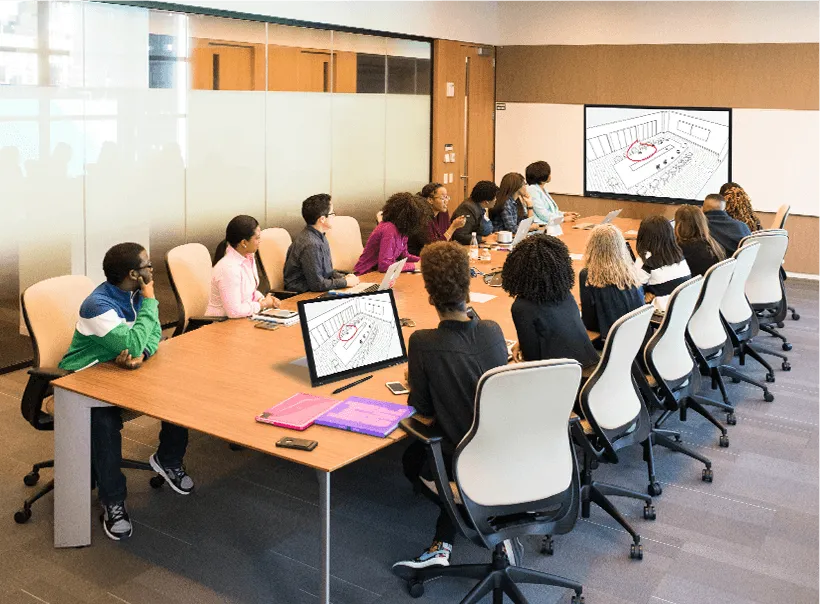
Remember the learning pyramid? It shows us that students retain a whopping 90% of what they learn when they teach others or immediately apply it.
That's the magic of cooperative learning—it makes students active participants. Instead of merely memorizing facts, they're crafting skills that stick. They're engaging, discussing, and learning by doing. And let's not forget the social skills, critical thinking, and problem-solving abilities they're honing along the way.
· Think-Pair-Share: Start with a prompt. Students ponder it, pair up, and then share their thoughts. Great for kick-starting discussions. This method encourages active participation and allows students to benefit from diverse perspectives.
· Think-Pair-Square: It's like leveling up from pairs to a foursome, sharing insights and deepening the conversation. This approach promotes deeper collaboration and encourages students to explore multiple viewpoints.
· Turn to Your Neighbor: A quick brainstorming duo. Pose a question, and students chew it over with their nearest classmate, fostering immediate engagement and allows students to quickly share ideas and build upon each other's thoughts.
· Fishbowl Debate: Dive into debates with this setup. Small groups tackle big topics, then share their insights, lighting up the whole classroom with fresh perspectives, which promotes critical thinking and communication skills while encouraging respectful discourse among peers.
· Buzz Groups: Present a problem, and let the groups buzz with solutions. Each team takes a unique stance, bringing varied solutions to the table, thus encouraging creativity and teamwork as students collaborate to find innovative solutions to challenges.
· Jigsaw Method: Divide and conquer complex issues by breaking into expert groups and then reshuffling to spread the knowledge. This approach promotes mastery of content as students become experts in specific topics and teach their peers, fostering a collaborative learning environment.

Grouping students can be straightforward or strategic. You could go random, with a simple count-off, ensuring a mix-up. Or, get tactical with it:
· Homogeneous Grouping: Pair high achievers or those needing a boost together, catering to specific learning levels. This approach allows for targeted instruction and peer support among students with similar abilities.
· Heterogeneous Grouping: Mix things up for a rich blend of insights and skill levels—a real-life skill builder. This method fosters collaboration and empathy as students learn from one another's diverse perspectives and experiences.
· Interest-based Grouping: Group students by their passions. Whether it's TikTok or K-Drama, shared interests can fuel engagement. This strategy enhances motivation and encourages active participation by allowing students to explore topics they are passionate about.
· Learning Styles: Use students' preferred learning methods to group them. It's all about playing to their strengths. By accommodating different learning styles, students can maximize their understanding and retention of material.
And hey, why not let students pick their own groups now and then?
Giving them choice can ramp up their commitment to the task at hand.
Let students to take ownership of their learning experience and fosters a sense of responsibility and accountability.
Technology integration is a common way for enhancing experience in collaborative learning. Technology enhances engagement, communication, and knowledge sharing among students. Here are several strategies to incorporate technology into collaborative learning:
Communication Tools: Utilize platforms like Zoom, Microsoft Teams, or Google Workspace for real-time communication, file sharing, and collaborative document editing. Thus enriching the learning area from offline classroom to online teaching occasions, the collaborative learning will not be limited by location.
Project-Based Work & Learning: Implement project management tools such as Trello or Asana to organize tasks, track progress, and facilitate teamwork. Or, we can also choose wireless sharing devices like IQShare WP40 to foster group sharing during group learning occasions.
Immersive Learning Tools: Explore immersive technologies like virtual reality (VR) , augmented reality (AR) or interactive flat panel like IQTouch series for interactive simulations, virtual field trips, or collaborative problem-solving activities.
Game-Based Learning: Integrate game-based platforms such as Prodigy, Kahoot, or Quizizz to gamify learning activities, foster competition, and encourage teamwork. Besides, we can also add interactive learning tools like IQClick interactive response system to assist teachers gather results and increasing interactive within classroom.
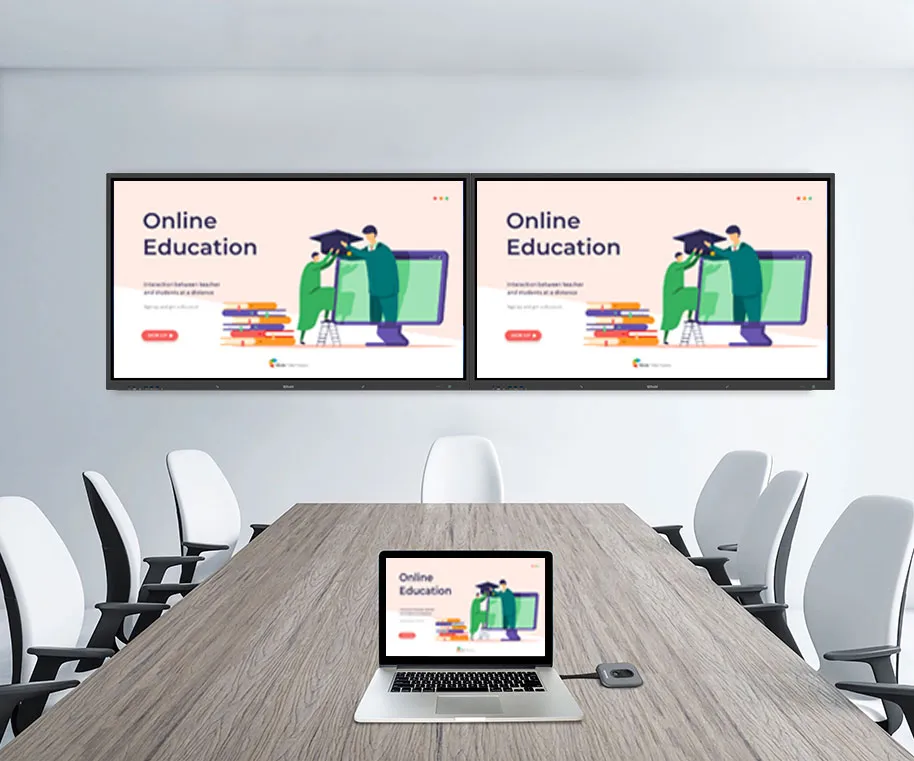
By leveraging technology tools and platforms, educators can create dynamic and interactive collaborative learning environments that promote active participation, knowledge exchange, and skill development among students.
Cooperative learning isn't just a nice-to-have; it's a must-do in today's classroom. As we look to foster collaboration and nurture essential 21st-century skills, letting students learn together is key. Gone are the days of solo slogs through textbooks. Here to stay are vibrant, interactive classrooms where learning is a shared adventure. So, why not give these strategies a go? Your students will not only learn more effectively but they'll also have a blast doing it.
Remember, if you're keen to keep exploring innovative teaching strategies, hitting that subscribe button goes a long way. Here's to making learning more engaging, one group at a time.
Here are some other articles that we think might interest you:
The Integration of Active Learning and Technology in Collaborative Lessons
Maximizing Collaboration: The Best Smartboard Interactive Flat Panels of 2024
1. Introduction
The ability to promptly and efficiently start meetings plays an important role in fostering team collaboration and boosting overall work efficiency. This article endeavors to furnish you with a straightforward and efficient operational guide, aiding you in swiftly commencing meetings to facilitate a more seamless workflow.
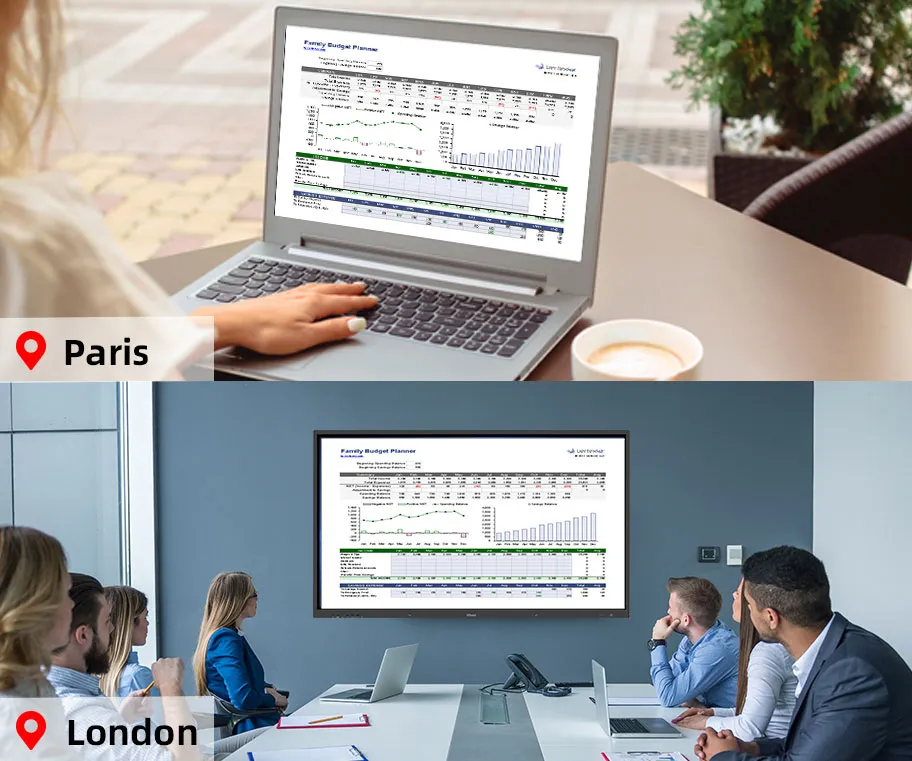
There are several benefits of Swiftly initiate an online Meeting:
Initiating meetings promptly avoids time wastage and keeps participants focused on the agenda, fostering more productive discussions. This efficiency ensures that meetings accomplish their objectives efficiently, maximizing the use of everyone's time.
Starting and concluding meetings on time reinforces a sense of urgency, discouraging non-essential discussions and promoting efficient time utilization. This practice sets a standard for punctuality and professionalism within the team or organization.
Swiftly starting a meeting reflects professionalism, leaving a positive impression on participants and contributing to a conducive and productive work environment.
Efficiently starting meetings is essential for optimizing collaboration, enhancing decision-making processes, and maintaining a positive workplace atmosphere.
In the following, we will provide a step-by-step operational guide for quickly starting a meeting room, which can assist you greatly leverage every meeting minutes and make meeting efficiently. This includes:
Choose suitable meeting platforms and tools that align with your team's communication needs and preferences. As for offline meetings, we can adopt the interactive annotation tools from IQTouch series, the wireless sharing system for screen sharing, thus instantly start and assist the meeting activation and record the ideas. As for offline meetings, we can leverage the presentation system, so that stably adopt the conferencing devices like cameras, speakerphones, reducing the concerns for cable mess during meetings.
Set explicit agendas and goals for the meeting to ensure participants are well-prepared and focused on the discussed topics, so that we can make sure every participants are fully immersed during the meeting.
Conduct pre-meeting tests for devices and connections to avoid technical issues and ensure prepared meeting environment for quick start to the meeting. By conducting these tests, you can prevent disruptions during the meeting and create a conducive environment for effective communication and collaboration. Taking the time to perform these checks demonstrates professionalism and commitment to a successful meeting experience for all participants.
Ensure all audio-visual devices, such as interactive flat panels, projectors, microphones, and cameras, are in working order. Also use appropriate cables to connect laptops, presentation devices, and audio equipment to the AV system, adjust the connection and setup way based on the conferencing topic and method.
Switch on all control devices, including touch panels or remote controls for audio, video, room lighting and air conditioners, etc., by schedule or remotely, to make sure that the room is cozy to start the meeting. Ensure control devices are configured with the correct settings for the meeting, including display preferences and audio levels.
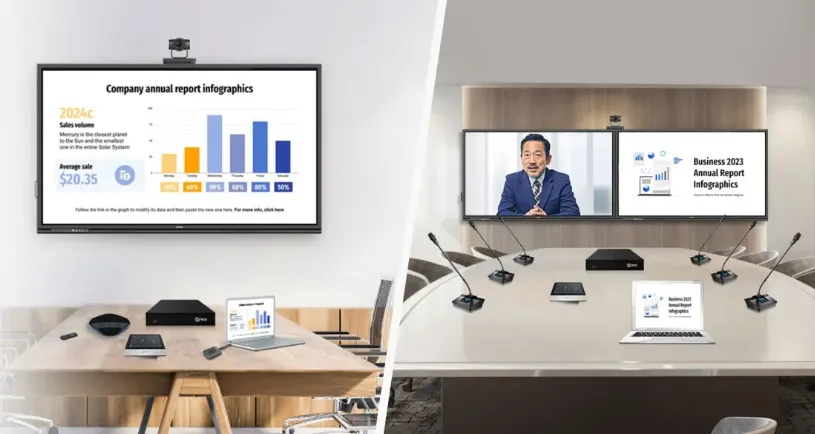
In particular, Q-NEX presentation switcher NPS100 can remotely control the conference devices to prepare the conference devices in advance.
Confirm microphones and speakers are set up to provide clear and audible audio throughout the meeting space. In particular, as for medium sized conference rooms, the appropriate speaker volume for amplifying local mics are essential and for online meeting occasions, the local mic and speaker need to work well for online attendees.
Visual check includes the display devices like the interactive flat panels and projectors. Verify that the display screen or projector is showing the intended content, and ensure the camera is properly aligned to capture all participants and adjust as necessary.
Adjust lighting, curtains, projection screens, etc., using control devices to enhance visibility and create a conducive environment. Continuously monitor audio levels and make adjustments if there are issues during the meeting.
Keep detailed meeting minutes and records to document discussions, decisions, and action items for future reference. In particular, IQTouch series provides the “scan QR code and take away” function, which greatly facilitates our recording and review of meeting content.
Efficiently following these steps will contribute to a streamlined and effective meeting experience.
Provide a checklist of things to be mindful of while starting and conducting the meeting.
Address potential technical issues, etiquette, and ways to maintain engagement.
Evaluate the meeting space to understand audio-visual requirements and check the functionality of devices in advance based on the meeting type. This ensures a smooth start and reduces the likelihood of interruptions.
Select appropriate audio-visual equipment based on the meeting's nature and requirements, including considering factors such as room size, number of participants, and the need for remote participation.
Ensure all necessary wiring and connections are set up, reducing delays in starting the meeting. Properly configured connections minimize technical issues and ensure seamless communication throughout the meeting.
Test microphones and speakers to guarantee clear and effective communication. Poor audio quality can hinder understanding and lead to frustration among participants. Regularly testing audio equipment helps maintain high-quality communication.
Power on control devices, configure settings, and have them ready for immediate use. Having control devices readily available streamlines the meeting process and allows for quick adjustments as needed.
Verify the functionality of audio-visual devices and control systems at least five minutes before the meeting to avoid technical glitches. Conducting thorough equipment tests reduces the risk of interruptions and ensures a smooth meeting experience for all participants.
Ensure adequate lighting for clear visibility, both for in-person and remote participants. Proper lighting enhances engagement and ensures that participants can see each other clearly, facilitating effective communication and collaboration.
Verify a stable internet connection to prevent disruptions during the meeting. A reliable internet connection is essential, especially for remote participants, as it ensures seamless communication and prevents delays or dropouts during the meeting.
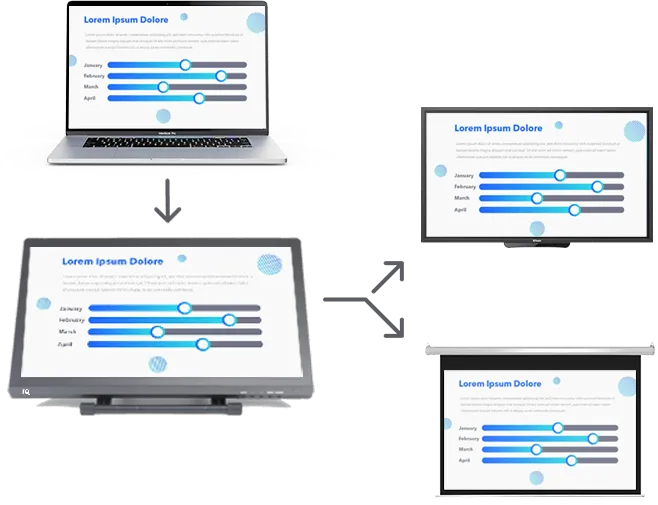
Optimize audio and video from the perspective of remote participants to enhance their engagement. Pay attention to factors such as camera angles, audio clarity, and screen sharing to ensure remote participants feel included and can actively participate in the meeting.
Here would like to list several frequently asked questions for you.
Conducting a pre-assessment helps evaluate the meeting space and ensures audio-visual requirements are met, reducing delays.
Select equipment based on the meeting's nature and requirements, ensuring it aligns with the intended purpose.
Ensure all necessary wiring and connections are set up to avoid technical issues and delays during the meeting.
Test microphones and speakers in advance to guarantee clear and efficient communication during the meeting.
Power on control devices, configure settings, and have them ready for immediate use to streamline the start of the meeting.
Verify the functionality of devices at least five minutes before the meeting to prevent technical glitches and disruptions.
Ensure adequate lighting for clear visibility, both for in-person and remote participants, optimizing the overall meeting experience.
Verify a stable internet connection to prevent disruptions and ensure a seamless meeting experience.
Optimize audio and video for remote participants, considering their perspective to enhance engagement.
IQ is a top education and conference solution provider. It has designed many conference room solutions of different sizes and functions. If you are looking forward to the efficient use of conference rooms, you can contact us based on your new conference room or existing conference room. The conference room has been upgraded to enjoy an immersive conference experience.
Here are some other articles that we think might interest you:
Transform Your Conference Rooms with Q-NEX Networked Presentation Switcher
Symphony of Connectivity: Redefining Presentation Dynamics
Elevate Your Boardroom Meeting with Q-NEX Networked Presentation Switcher

Lecture capture brings tremendous convenience to classrooms and students.
Educational institutions worldwide are increasingly adopting lecture capture systems due to their myriad benefits. Here are several compelling reasons why educators are incorporating these systems into their teaching methodologies:
Lecture capture systems provide students with the flexibility to access recorded lectures at their convenience. This is especially valuable for learners with diverse schedules, accommodating part-time students, working professionals, and those with varying learning paces.
The ability to review recorded lectures allows students to reinforce their understanding of complex topics. This review process aids in clarifying concepts, revisiting challenging sections, and consolidating knowledge, contributing to improved academic performance.
Lecture capture systems facilitate remote learning, enabling students to engage with educational content from anywhere. This feature has become increasingly crucial, especially during unforeseen events like the global pandemic, where traditional in-person classes faced disruptions.
Interactive features within some lecture capture systems, such as quizzes, polls, and discussions, contribute to heightened student engagement. These tools transform passive learning into an active and participatory experience, fostering a deeper understanding of the subject matter.
Students have diverse learning styles and preferences. Lecture capture systems cater to visual and auditory learners by providing multimedia content. This versatility ensures that educators can appeal to a broader audience and accommodate various learning preferences.

Recorded lectures serve as valuable revision resources during exam periods. Students can revisit specific lectures, focus on challenging topics, and prepare more effectively for assessments. This aids in reducing stress and improving overall academic outcomes.
Lecture capture systems not only benefit students but also support professional development for educators. Teachers can review their own lectures, identify areas for improvement, and refine their instructional techniques, fostering continuous growth and effectiveness in their teaching practices.
Learners progress at different paces, and lecture capture accommodates this variability. Students can navigate through content at their own speed, pausing, rewinding, or fast-forwarding as needed. This personalized learning approach caters to individual student needs and promotes a self-paced educational experience.
Lecture capture systems have evolved to cater to diverse educational needs. Here are various types of the lecture recording systems:
Traditional lecture capture systems involve dedicated hardware components, such as video station for touch and recording operation, auto-tracking cameras and ceiling microphones strategically placed in classrooms, such as IQTouch LCS710. These systems ensure high-quality video and audio recording.
Software-based lecture capture systems leverage existing hardware like computers and webcams. These solutions often come with easy-to-use interfaces, making them accessible for educators with simple setup and lower budget. Besides, we can also leverage the mainstream video conferencing software for this function.
Some lecture capture solutions seamlessly integrate with smart classroom technologies, such as interactive whiteboards and digital displays like IQTouch series. This all-in-one integration enhances the overall teaching and learning experience.
Mobile-centric lecture capture systems allow educators to capture lectures without limitation for location like IQVideo LCS910. This flexibility enables recording in various environments beyond the traditional classroom setting like auditoriums, gyms, and playground.

IQVideo LCS710 provides lecture capture hardware systems that with highly integrated design that consists of devices including video station, auto-tracking cameras for teacher and students, and ceiling microphone, which reduces concerns for implementing multiple devices and compatibility, allowing educators to capture and manage multimedia content effortlessly.
Panopto offers a comprehensive lecture capture solution, allowing educators to record, stream, and manage video content seamlessly. Its hardware setup includes cameras, microphones, and capture appliances, ensuring high-quality audio and video recordings.
Echo360 provides lecture capture hardware solutions designed to enhance student engagement through active learning. Its hardware includes cameras with tracking capabilities, microphones, and capture devices, enabling educators to deliver dynamic presentations while recording content for later review.
Kaltura offers lecture capture hardware designed for educational institutions to create, manage, and distribute video content efficiently. Its hardware solutions include cameras, microphones, and capture appliances, providing educators with the tools needed to deliver engaging lectures and tutorials.
Matrox offers lecture recording hardware solutions designed for classrooms and lecture halls. Its systems include capture cards, video encoders, and streaming appliances, enabling educators to capture, encode, and distribute high-quality video content in real-time or for later playback.
Here are some common misconceptions about lecture capture systems:
Some individuals mistakenly believe that lecture capture systems are inherently complex and difficult to use. However, in reality, modern systems are designed with user-friendly interfaces, ensuring that educators can easily navigate the recording and storage processes without requiring extensive technical expertise.
Another prevalent misconception is the assumption that implementing lecture capture systems involves significant device debugging efforts. This belief is outdated, as contemporary lecture capture solutions come as comprehensive packages with streamlined setups, minimizing the need for intricate hardware configurations and troubleshooting.
There is a misconception that recording lectures might have a detrimental impact on the overall teaching experience. Contrary to this belief, lecture capture systems have been proven to enhance teaching effectiveness. Educators can review their instructional methods, identify areas for improvement, and provide students with valuable resources for reinforcing their understanding of the course material.
These misconceptions often hinder the widespread adoption of lecture capture systems by creating unwarranted concerns. In reality, these systems are designed to simplify the recording process, improve teaching outcomes, and offer flexible learning opportunities for both educators and students.
Q: Does recording lectures consume significant storage space?
A: Most systems provide cloud storage solutions, alleviating storage burdens.
Q: Are additional hardware devices necessary?
A: Most systems only require basic cameras and microphones, complemented by conferencing software for usage.
The best lecture capture systems in 2024 not only offer convenience but also enhance teaching effectiveness. Educators and students can engage in more flexible learning and teaching experiences through these systems.
Here are some other articles that we think might interest you:
Flipped Classroom Recording System
Exploring Lecture Recording and Streaming Solutions
Breaking the Limits of Learning: Lecture Capture Classroom Empowers Remote Education
When selecting an interactive flat panel (IFP), various factors must be taken into account to ensure that it meets your specific needs and provides a seamless interactive experience. Making an informed decision before purchasing an IFP is essential for a seamless integration into your space. Here's a breakdown of considerations across different aspects.
Hardware stands as the core factor influencing product performance, pricing, and overall user experience. Aspects within hardware, such as size and functionalities, can be meticulously balanced in consideration of our specific application scenarios, ensuring a harmonious integration with our unique requirements and preferences.
The dimensions of the IFP play a pivotal role, influencing the immersive quality of presentations or collaborative sessions within a given space. Larger sizes cater to expansive environments, while smaller dimensions suit more confined settings, providing a nuanced approach to spatial requirements.

A nuanced examination of the IFP's functionality is paramount, encompassing a meticulous evaluation of both general and specialized features. Whether the IFP serves normative purposes or boasts distinctive functionalities tailored for specific applications such as educational or conferencing settings, this consideration ensures alignment with bespoke needs.
The overall build quality and display characteristics of the IFP directly impact user experience. Factors such as screen resolution, color accuracy, and touch sensitivity contribute to an immersive and reliable interactive encounter.
Assessing the connectivity options available, ranging from conventional ports like USB and HDMI to advanced wireless capabilities, ensures seamless integration with diverse devices, promoting unhindered collaboration.
Beyond the hardware realm, we must delve into the adaptability of the desired product to our specific needs and application scenarios. Evaluating the resonance between the product and the demands of our usage scenarios allows us to gauge whether the LCD can effectively meet the practical requirements of our experiential expectations.
The user interface and navigational elements significantly influence the overall user experience. Intuitive controls and user-friendly design enhance accessibility, contributing to a more efficient utilization of the IFP.
Delving into the inclusion of application support for pertinent occasions such as education, conferences, or collaborative endeavors is crucial. An IFP's adaptability to various scenarios ensures versatility in its application, catering to diverse user requirements.
During the procurement process, it is prudent to consider the corresponding service strategies. Assessing whether the supplier engages in detailed discussions regarding the product's applicability to our usage scenarios is crucial. This not only aids in discerning the subsequent service support but also provides insights into the supplier's technical background. Opting for a supplier with robust capabilities typically ensures a more stable post-purchase service experience.
Technical background and expertise of the supplier constitute a crucial determinant of product quality and innovation, ensuring alignment with evolving technological landscapes.
Evaluating the support offered by the supplier both before and after the purchase is paramount. A responsive and helpful presales team, coupled with robust after-sales support, ensures a smooth and satisfactory overall experience.
The enduring quality of the IFP, encompassing its robustness and resilience to sustained usage, is a pivotal factor. Durability guarantees a prolonged lifespan, minimizing the need for frequent replacements or repairs.
Apart from the aforementioned influencing factors, several other considerations warrant inclusion in our contemplation, including:
Opting for the latest version of the IFP ensures future-proofing, prolonging its relevance and usability amid the ever-evolving landscape of technological advancements. This strategic consideration safeguards against premature obsolescence.
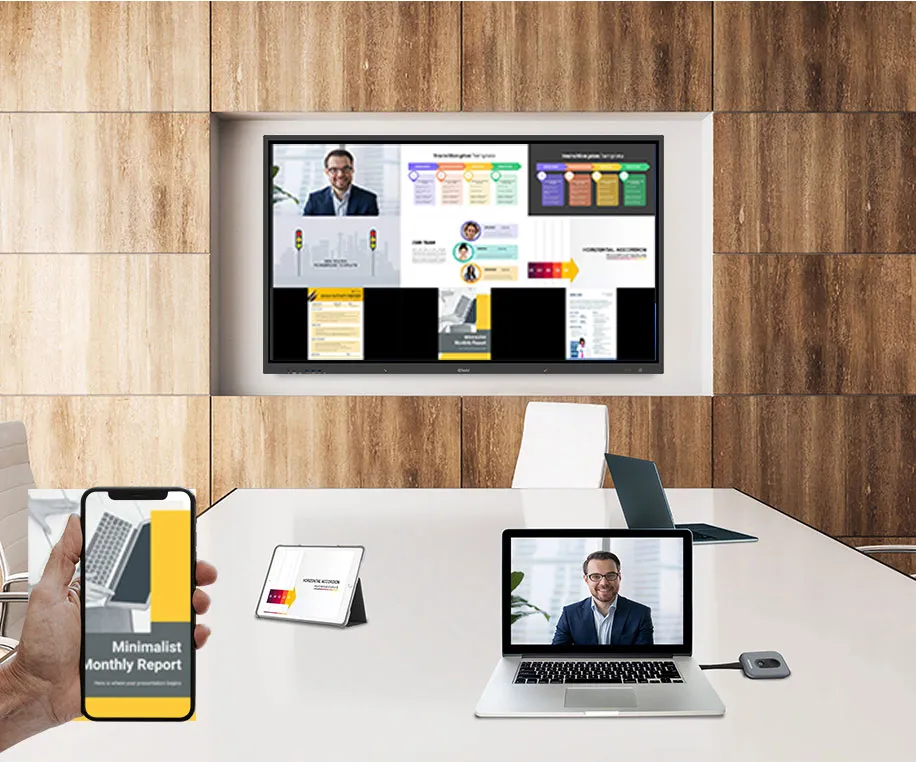
Beyond the aforementioned considerations, miscellaneous factors such as power efficiency, environmental impact, and potential for software upgrades warrant attention. A holistic assessment encompassing these nuanced facets guarantees a well-informed decision in selecting an IFP that aligns seamlessly with the unique requisites of the user.
Interactive flat panels continue to evolve in 2024, driven by technological advancements and changing market demands. Here are the prominent trends shaping the landscape:
Market Growth and Size: The interactive flat panel market is experiencing substantial growth, with a predicted CAGR of 10.4% by 2024, indicating a robust industry expansion globally.
Technological Innovation: Ongoing technological advancements are introducing innovative features such as multi-touch capabilities, improved resolutions, and enhanced interactivity, providing users with a more engaging and seamless experience.
Increased Demand: The demand for interactive flat panels is on the rise, as reflected in the market size crossing USD 12.5 billion in 2023. This upward trajectory is expected to continue with a projected 9% CAGR from 2024 to 2032, driven by growing applications in various sectors.
Digital Signage Integration: Interactive flat panels are becoming integral components of digital signage solutions, allowing for dynamic content display and enhanced user engagement. This trend is expected to gain further traction in 2024.
Educational Adoption: Interactive flat panels are increasingly adopted in educational settings, transforming traditional classrooms into interactive learning environments. The trend towards digitizing education is likely to drive the demand for these panels in 2024.
Interactive flat panels (IFPs) continue to evolve, offering advanced features that redefine collaborative and educational experiences in 2024. The following technical trends highlight the cutting-edge capabilities of IFPs this year:
5G Integration: IFPs are incorporating 5G connectivity to ensure faster and more reliable data transmission. This facilitates seamless collaboration and content sharing during interactive sessions, enhancing the overall user experience.
AI-Powered Smart Features: The integration of Artificial Intelligence (AI) enhances IFP functionality. AI-driven capabilities include intelligent object recognition, automated content organization, and adaptive learning features, catering to diverse educational and business needs.
Augmented Reality (AR) and Virtual Reality (VR) Integration: IFPs are embracing AR and VR technologies, providing immersive and engaging experiences. This trend is particularly prominent in educational settings, where students can explore virtual environments directly on the flat panel.
Advanced Touch and Gesture Controls: Improved touch sensitivity and gesture controls enhance user interaction. IFPs are employing more advanced touch technologies, such as infrared and optical sensing, to ensure precise and responsive touch input.

Wireless Connectivity Standards: IFPs are adopting the latest wireless connectivity standards like Wi-Fi 6, enabling faster and more reliable connections. This facilitates wireless screen sharing and collaboration without compromising on quality.
Cloud-Based Collaboration: IFPs are leveraging cloud-based platforms for enhanced collaboration. Users can access, share, and collaborate on documents in real-time through cloud integration, fostering a more dynamic and flexible working or learning environment.
In conclusion, a thorough evaluation of these eight factors will empower you to select an interactive flat panel that aligns seamlessly with your requirements, ensuring a transformative and effective interactive experience.
Here are some other articles that we think might interest you:
Unveiling the Future of Interactive Learning and Collaboration IQTouch HA1100Pro
Enhancing Digital Education with IQTouch HA1100 Pro for Virtual Laboratory
Exploring the 5 Cutting-edge Audiovisual Technologies of IQTouch HA1100 Pro
The biggest feature of the world today is connectivity. From connection to collaboration, innovation, and productivity must be the cornerstones of collaborative communication. Whether in the classroom or in the conference room, smart board interactive flat panel displays have become the key to achieving this spirit of collaboration. As we move into 2024, with more and more smart products taking connectivity a step further, let's explore the leading interactive flat panel displays through the many standards and product choices listed in this article.
Smartboard interactive flat panels are advanced displays that allow users to interact with digital content directly on the screen using touch gestures, styluses, or remote connectivity. They have revolutionized presentations, teaching, and collaborative work by combining the best aspects of traditional whiteboards with cutting-edge technology.

What is a smart interactive tablet? In essence, the intelligent interactive flat panel is a touchscreen display with a larger size for more people to use. Because interactive flat panels can provide users with the ability to interact directly with digital content. In terms of product composition, they are equipped with advanced sensors that can detect touch and stylus input, allowing multiple users to write, draw, or manipulate data on the screen at the same time, which is largely provided by features such as multi-touch or writing sensors.
The evolution process of intelligent interactive flat panels is full of innovation. Updates are made through a confluence of usage feedback and advances in technology. Resulting in a more optimized generation of products. The journey of the Intelligent interactive flat panel began with the advent of the first interactive whiteboard, which contained a projector and a touchpad. With the advancement of technology, these systems evolved into fully integrated tablets, integration to meet the integration of more functions in one, more convenient, and more efficient.
When choosing the best smart board interactive flat panel display, we should consider several important criteria. In this way, it can be selected to meet the needs of users and their environment. Here are a few key factors that we believe need special consideration.
The most important feature of an interactive tablet is its interactivity. The interactive behavior uses finger touches and movements to prompt the interactive flat panel system to record touches quickly and accurately. Unlike personal mobile phones, interactive flat panels are often used in collaborative work or study places, so the best performance should support multi-touch to allow multiple users to interact at the same time.
The display quality of the screen often presents different display quality because of the production type of the screen process. In the mainstream market demand, customers are often looking for high-resolution screens, because they can provide clear and sharp images and text. In addition, some anti-fingerprint and anti-glare properties are also additional criteria to evaluate the quality of the interactive flat panel. On the one hand, anti-glare surfaces reduce reflections and maintain visibility in bright environments. In addition, good contrast can clearly present bright colors, giving users a better visual perception.
The size and aspect ratio are the basic parameter information of the interactive flat panel. Size options should be appropriate for various room sizes and viewing distances.
The main forms of connection are wired connection and wireless connection. A good interactive flat panel should be equipped with enough ports for HDMI, USB, Type-C, and other connections. Wireless connectivity options such as Bluetooth and Wi-Fi should be easy to use and flexible.
Of course, it would necessarily be better if we chose an interactive flat panel that is compatible with a variety of devices, including PCs and smartphones.
If we choose an interactive flat panel with many built-in tools and software that facilitate collaboration, such as digital whiteboards and screen sharing. It makes it easy to save and share important records of work sessions, and this is one of our key criteria for selecting a quality interactive flat panel.
The interactive flat panel requires a built-in speaker that transmits clear sound quality and is suitable for multimedia use. Of course, we can also choose to use audio equipment with it, but products that integrate multiple functions are often more pleasing.
From the point of view of evaluating hardware performance, the interactive flat panel should be structurally robust and withstand frequent use. The cost of an interactive flat panel is already relatively high, and if you buy a vulnerable product with poor quality, it will also cost you more to maintain. Besides, we also need to make sure the product after-sales team is reliable and patient, then troubleshooting and maintenance support is not very laborious.

Interactive flat panels provide us with innovative ways to engage, collaborate, and present information. As of 2024, the market has witnessed technological advances in the field of numerous interactive flat panel products, with more specialized models for the market and users to choose from. Below are some of the top interactive flat panels, each of which has been selected for its performance, functionality, and user experience.
The powerful IQTOUCH TB1300 PRO for business and education stands out for its rich display options and cutting-edge technology. It comes with award-winning teaching software, making it a school favorite. 98-inch and 110-inch models are available for large meeting spaces and classrooms. The advanced Android 13 operating system and IQ OS V5.0 are used to provide a smooth user experience. Proximity sensors are integrated to improve energy efficiency, activating the screen when the user approaches. In addition, it provides excellent sound quality through high-resolution AI cameras and microphone arrays, enabling clear communication and meetings.
Promethean's ActivPanel series is known for its educational focus and robust software ecosystem. It not only has a durable structure to meet the needs of classroom use. It also supports wireless screen sharing, allowing students and teachers to contribute from their devices.
The SMART 7000R Pro series is tailored for business environments and emphasizes seamless integration with enterprise tools: Utilize HyPr Touch™ and EMR technology to provide superior touch and ink accuracy. Equipped with SMART Meeting Pro® software to improve the efficiency of the meeting.
ViewSonic's ViewBoard is the perfect blend of interactivity and economy: offering 4K ultra HD resolution for superior image clarity. Includes myViewBoard™ digital whiteboard software to facilitate collaboration. Enable dual pen functionality and provide USB-C connectivity for versatility. Integrated IoT sensor centers for smart environment adjustment and asset management.
The Microsoft Surface Hub 2S is a stylish addition to any modern workspace: it features a brightly colored high-resolution PixelSense™ display that supports multi-touch and pen input. It also runs on Windows 10 and provides seamless integration with Microsoft's suite of productivity tools, which provides easy mobility and a modular design to accommodate a variety of workplace configurations.
IQBoard's smart whiteboard was developed to continuously meet the collaboration needs of the ever-changing modern workspace and educational environment. Through the characteristics of this paper, we believe that, in general, the IQTOUCH TB1300 PRO is a fusion of innovation and practicality. With its high-performance specifications and user-centric design, it promises to deliver transformative interactive experiences. Expect this product to be the best assistant for your work environment in 2024. If you're interested in this interactive flat panel or one of its series products, you can contact us here to unlock more immersive presentations and interactions on a larger screen.
Here are some other articles that we think might interest you:
The Benefits of Using a 100-inch Interactive Flat Panel in Education Settings
Unleashing Creativity in Presentations with 100-Inch Interactive Flat Panels
Increase Engagement with a Large Screen: The 100 Inch Interactive Flat Panel
Copyright © 2017.Returnstar Interactive Technology Group Co., Ltd All rights reserved.




